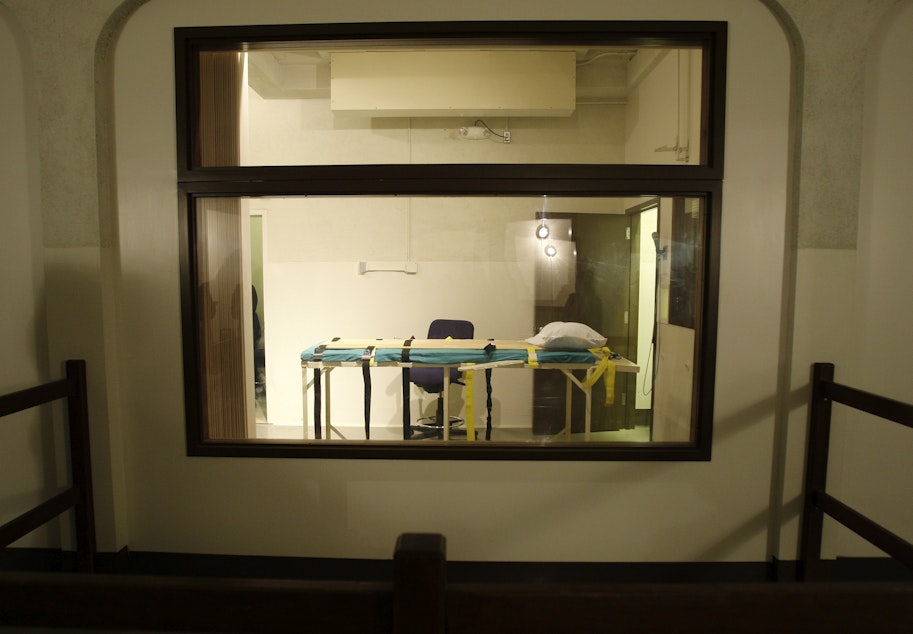A death chamber goes dark in Washington state

You need 100 feet of rope to hang a man – a macabre detail former penitentiary captain Dick Morgan learned on the job. But crucial to know, because a misstep is too gruesome to describe.
“I was terrified that we'd screw it up,” Morgan said this week from Walla Walla, where he worked for decades, and where his father and grandfather worked before him.
Morgan participated in two executions at the penitentiary, and attended one in 2001. Ultimately, he would actively oppose government-sanctioned executions.
“I've always felt very strongly that it's just antithetical that a government would kill its own citizens no matter what they did,” Morgan said.
The death chamber was officially retired this week. At a ceremony on Wednesday, Gov. Jay Inslee said the death penalty was grossly unequal in its application where in some cases, the difference between life without parole and death was the county line or the color of your skin.
“We want a fair system, where people get the same punishment for the same crime,” Inslee said.
The end of capital punishment in Washington is complicated because of the heinousness of the crimes. Some prosecutors argued that it was an important law enforcement tool. Charles Baxter, a taxi driver for Fast Taxi in Walla Walla, would have liked to have seen his sister’s killer executed. She died in 1978.
“Why wouldn't you execute him? He claimed to do it,” Baxter said. “He's not rehabilitated. It'd be different if he was drunk and hit somebody and killed him.”
The death chamber is in the oldest part of the prison, surrounded by brick and walls of concrete.
There a condemned man would spend his last hours in one of two cells. Outside, a beige phone is still mounted on the wall. It’s a short walk to the gallows.
Below the gallows is another small room, with a gurney, where the prisoner would be strapped down ahead of lethal injection.
And there’s a trap door in the ceiling, where a hanged man would fall through.
The sound of that trapdoor is a sound that Morgan and others say is hard to forget. So loud and startling it would spook inmates in a nearby wing for days.
Morgan was intent on performing the grim job professionally. He said he chose his execution teams carefully and never accepted volunteers. He worried people’s motivations might be ghoulish.
“Everybody I assigned a task, it was always very clear they had the absolute right of refusal,” Morgan said. “One told me, ‘Okay, I'll do it, but my wife can't find out.’ So anonymity was a big deal, and everybody understood when it's over, you don't talk about it.”
Maintaining a solemn atmosphere was a lesson imparted on him from talking with his father, who witnessed a hanging while working as an officer at the penitentiary in the 1940s. His father described the scene as a carnival, with people laughing.
“The only thing missing was the popcorn,” Morgan said. “He was disgusted.”
When he had to prepare for a hanging, Morgan found a retired hangman to help, “an emphysemic, overweight old man” they flew up from Florida.
“He knew his stuff, that’s for sure,” Morgan said.
The man took one look at their set-up and asked them, “How many feet of rope?”
Morgan told him 50 feet. The man replied, “You need 100.”
The hangman then asked, “What are you going to cut through the rope with?”
“Well, we hadn't figured that out,” Morgan said this week. “We thought a great, big bolt cutter would work. He said, ‘Hacksaw, 32-bit blade.’”
Lethal injection became the tool of choice to kill inmates on death row, which Morgan said was not necessarily more humane than hanging.
“It seems very humane, because you just go to sleep and quit living, but it's a long, drawn out process of getting the man out onto the table, and getting the needles in place,” he said. “It takes a long time from start to finish.”
The death chamber will be preserved for history, and it will always live in mine.
I was a media observer the night Cal Brown was executed. I’ve thought about this space many times since then. The lethal injection table, the repurposed car seat belts that secured the condemned.
It was a solemn professional event.
No spectacle.
Today, a commemorative plaque on the wall includes a quote from Governor Inslee when the ultimate decision is death.
“There is too much at stake to accept an imperfect system.”




